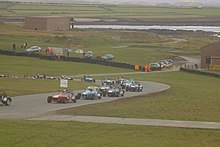Anglesey Circuit

Address: |
|
|
|
|
||
| Route type: | permanent race track | |
|---|---|---|
| Track layout | ||
| Route data | ||
| Route length: | 3.38 km (2.1 mi ) | |
| Curves: | 10 | |
| Curve superelevation: | up to 10 ° | |
| https://www.angleseycircuit.com/ | ||
Coordinates: 53 ° 11'25.4 " N , 4 ° 29'52.9" W.
The Anglesey Circuit ( Welsh : Trac Môn ) is a permanent racing circuit in the United Kingdom .
overview
Anglesey Circuit is located near the settlement of Tŷ Croes on the island of Anglesey in North West Wales . The route is located directly on the cliffs of the south coast and offers a modern design as well as a spectacular view of the Irish Sea and the mountains of Snowdonia National Park .
Since the track was rebuilt in 2006 and 2007, the Anglesey Circuit has been one of the most modern circuits in the UK. However, due to the remote location and the high probability of wind and rain, popular racing series avoid the track.
However, Anglesey is often used for popular and amateur sports events, for vehicle and technology tests and for free driving. The British car magazine Fifth Gear , which was founded in 2002 by Tiff Needell and Vicki Butler-Henderson after they left Top Gear , also uses the Anglesey Circuit for their vehicle tests.
history

Beginnings
Unlike many other racetracks in the United Kingdom, on former military airfields of the RAF were built on Anglesey Circuit was formerly no flight operations. The site was used by the military and the like until the 1990s. a. used as a training facility for artillery units and as a radar station. In October 1992 the Wirral 100 Club organized the first motorcycle races on the former military base. At that time, the roads and farm roads of the base served as the route. There were hardly any functional buildings, but the surface of the route and the good organization were praised. After the first event was a success, more races were held in the years that followed. The first car races and rallycross races , which were even part of the British championship, were also held.
modification
In 1997 the racetrack was expanded and rebuilt in order to obtain the necessary license to host various races. A new building complex was erected and several chicanes were built into the Menai Straight. A small pit lane was also set up, but without permanently installed garages.
New building
In 2006 and 2007 the Anglesey Circuit was completely renewed. Only the start-finish straight and Beth's Bend were retained from the old route . For the new run of 300,000 tons of topsoil , 70,000 tons of material for the base course and 50,000 tons of asphalt moves. In addition, 7,000 meters of drainage pipe, 2,000 meters of fences, 10,000 truck tires, 2,000 meters of crash barriers and 9 tons of grass and wild flower seeds were used. A total of 5 miles of route markings were applied and a new pit wall was built.
Events
Apart from the major British motorsport events such as the BTCC or the British GT Championship , the Anglesey Circuit is used for many smaller motorsport events, especially in the amateur sector. In addition to circuit races for cars and motorcycles, there are special tests for rally vehicles , drift competitions and sprint races. Due to the new route, rallycross races have not been held since 2007 .
Track layouts
Until 2006
Initially, the Anglesey Circuit consisted entirely of the streets and paved areas of the military base. In 1997 the route was revised, u. a. Chicanes were built into the Menai Straight and a pit lane was built. The Anglesey Circuit remained largely unchanged until the major new building in 2006.
Since 2007
Since the renovation in 2006 and 2007, the Anglesey Circuit can be used in four different variations. The shortening of the route enables individual use, which makes the Anglesey Circuit interesting not only for motor sport events, but also for car magazines and vehicle tests.
The longest variant is International GP . It has a length of 3.38 km (2.10 mi ) and ten curves. The track width is twelve meters and the safety precautions and run-off zones meet modern standards. On this route there are areas for all speeds, from very slow to very fast. The route follows the terrain on the coast of Wales and there are also uphill sections due to the differences in altitude. The track can be used for almost all automobile and motorcycle races and is also clearly visible to spectators in many places.
Coastal is the second longest route variant at 2.49 km (1.55 mi). It has eight corners, compared to the International GP the two long straights and the hairpin The Hairpin are left out. The very popular Corkscrew is used as a shorter connection . Coastal is interesting because of the shortening for vehicles with lower engine power, but the theoretical maximum speed is similar to that of the International GP , since the high-speed range with the up to 10 ° banked curves from curve 3 ( banking ) to curve 4 ( Church ) and curve 5 ( School ) is passed through unchanged.
National is the only variant in which parts of the original route are still used. National has only six corners and is 1.93 km (1.2 mi) long. Racers and the press rate the School corner as one of the most challenging high-speed corners in Great Britain and Ireland . Therefore, School was taken over unchanged and National is based on the old course with comparable length and characteristics, but has been greatly improved in terms of the route width, the road surface and the run-off zones. National is considered one of the best short circuits in the UK . With two long straights, a hairpin curve, the fast School curve and the Rocket curve combination , it is very demanding.
Club is the shortest route on the Anglesey Circuit at 1.29 km (0.8 mi). With its short length, Club is particularly interesting for amateur (motorsport) club events, but with its twelve-meter-wide route, modern road surface, run-off zones and several demanding passages, it still offers similar conditions to the longer variants. Due to its short length, the club also offers good training opportunities. Club and National can be operated independently at the same time.
The long straight Tom Pryce between Corkscrew and The Hairpin is named after Tom Pryce . He drove Formula 1 races between 1974 and 1977 and is considered the most successful Welsh Formula 1 driver with two third places, 42 world championship points and tenth place overall in the 1975 season . On March 5, 1977, Pryce collided in Kyalami on a difficult-to-see section of the route with a marshal, and both died in the accident.
See also
Web links
- angleseycircuit.com Official Website
Individual evidence
- ↑ a b c d e f g h i Anglesey Circuit on racingcircuits.info, accessed on August 29, 2019.
- ↑ Circuit History on angleseycircuit.com, accessed August 29, 2019.
- ↑ Events on angleseycircuit.com, accessed on August 29, 2019.
- ↑ International GP on angleseycircuit.com, accessed August 29, 2019.
- ↑ Coastal on angleseycircuit.com, accessed on August 29 of 2019.
- ↑ National on angleseycircuit.com, accessed on August 29 of 2019.
- ↑ Club on angleseycircuit.com, accessed on August 29 of 2019.






